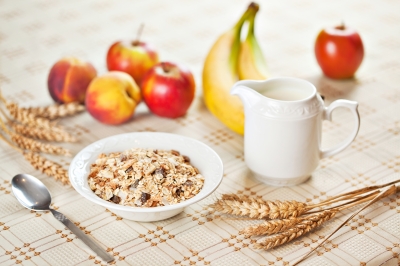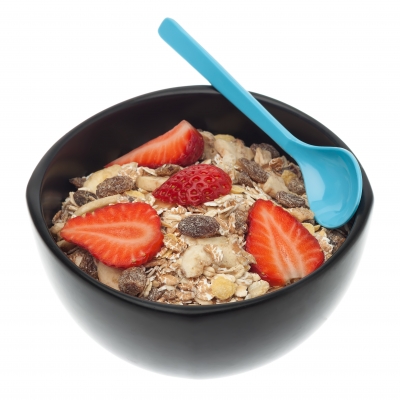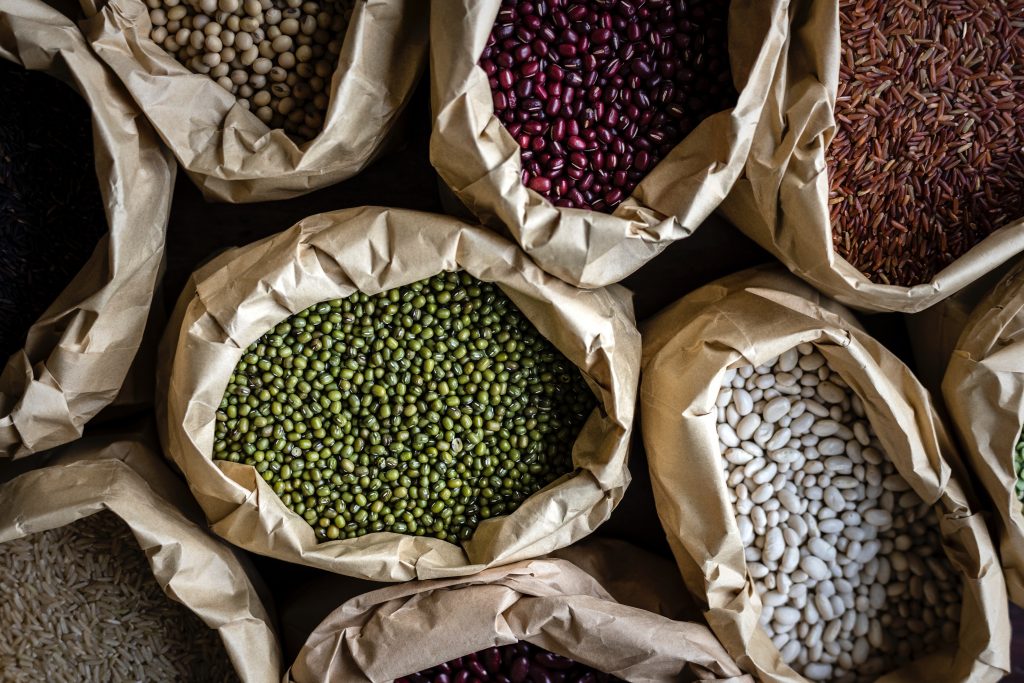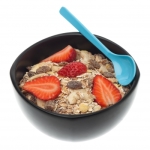4 Reasons Why You Need More Fiber
 How many grams of fiber do you consume daily?
How many grams of fiber do you consume daily?
Most Americans consume half the recommended dietary intake of 25 grams (women) to 38 grams (men) of fiber daily for adults 50 years or younger. Over the age of 50, women should consume 21 grams of fiber and men 30 grams per day.
There are two types of fiber.
Soluble fiber turns to a gel during digestion. Sources of soluble fiber include oats, oatmeal, nuts, seeds, beans, peas, lentils, and some fruits and vegetables (i.e. oranges, apples, carrots).
Insoluble fiber is not digested. It adds bulk to the stool and helps food move through the stomach and intestines. Sources of insoluble fiber include vegetables, whole-grains, and wheat bran.
A diet high in fiber is connected to many health benefits.
- Lower cholesterol levels
Boosting fiber intake from whole-grain products leads to a slower build-up of arterial plaque. Studies also find soluble fiber to protect against atherosclerosis, which is this build-up of plaque in the arterial walls.
Dietary fiber also binds to LDL cholesterol during digestion, resulting in lower LDL cholesterol levels, without decreasing HDL cholesterol levels.
Continue reading
Moms and dads: Are your children getting enough fiber?
 From keeping our immune system functioning to bowel regularity, our digestive systems do a lot for our everyday health.
From keeping our immune system functioning to bowel regularity, our digestive systems do a lot for our everyday health.
Dietary fiber as a regular part of your diet will promote lower cholesterol levels and improved heart health. Most of us consume about half of the fiber our bodies need to function correctly.
If we include fiber in the diets of our children now, we can make it a natural habit they continue into adulthood.
I asked registered dietitian Felicia D. Stoler, DCN, how parents can get inventive about ways to increase our family’s fiber intake. Stoler is the former host of TLC’s “Honey, We’re Killing the Kids,” and author of “Living Skinny in Fat Genes.”
Lisa Nelson, RD: How much fiber do we need?
Dr. Stoler: “Toddlers ages 1-3 need 19 grams of fiber daily. Children ages 4-8 years need 25 grams, about the same as adult women. Teenage boys and adult men should aim for 38 grams per day. That fiber requirement probably won’t be met by eating fast food. “A four-piece serving of chicken nuggets has just one gram of fiber. A six-inch turkey breast deli sandwich only has three grams.”
Lisa Nelson, RD: How do you get around the idea that a high-fiber diet means piling plates high with vegetables?
Dr. Stoler: “Sometimes playing ‘hide the fiber’ is the best way to improve a family’s nutrition.”
Lisa Nelson, RD: Can you give me some examples?
Dr. Stoler: “I’m always tossing ground flax seed into foods. One of my favorite tips is to use it as a thickener for tomato sauce or soup. Serving a lot of side dishes is a great way to load up on vegetables or grain-based foods. Along with a main course of poultry or fish, I prepare a lot of side dishes with beans, lentils and multiple grains. For flavor and color this time of year, toss in some cranberries.”
Lisa Nelson, RD: What about giving the family a high-quality fiber supplement?
Dr. Stoler: “I keep Sunfiber on the kitchen counter so it’s very convenient while I’m cooking. Since it’s odorless, tasteless and mixes easily into just about anything, it’s routinely my secret ingredient in a lot of foods from pancakes, waffles and muffins to chili, soup and yogurt. One scoop adds six grams of fiber, which is significant. It also helps support your family’s bone health because it supports better calcium and magnesium absorption.”
Lisa Nelson, RD: How can you add more fiber to kids’ party foods, especially if the event is at someone else’s home?
Dr. Stoler: “Offer to bring a snack for fall get-togethers. Kids go crazy for fruit kabobs. Just thread fresh melon balls onto wooden skewers. Then flip over half of the empty melon shell, and stick the skewers into it for a festive presentation. If you’re short on time, buy the pre-cut melon and stick the skewers in a Styrofoam ball from the craft store or invert a colander. When fruit is presented in an enticing way, people want to eat it.”
Lisa Nelson, RD: Do you have other creative tricks for getting kids to eat healthier?
Dr. Stoler: “Make sure plates are filled with colorful foods. Food that’s appealing stands a greater chance of getting eaten. Use cookie cutters to cut sandwiches made with high-fiber bread. Use a vegetable peeler to cut carrots or cucumbers into ribbons. Experiment with cutting other vegetables into fun shapes.”
Lisa Nelson, RD: What do you suggest for a high-fiber, family dessert?
Dr. Stoler: “Dress up fruits for dessert. The beauty of high-fiber desserts is that they fill you up, especially if you slow down and savor each bite. So you won’t be as tempted to over-indulge. Frozen grapes are fun and easy. Fruit cobblers are also a good choice for chillier evenings, especially if you sprinkle some Sunfiber into the mixture before baking. Making it with an oatmeal topping will add even more fiber and nutrients.”
Lisa Nelson, RD: Do you have any other suggestions for parents to encourage their kids to start eating more vegetables?
Dr. Stoler: “Include your children in creating menus, grocery shopping, gardening, setting the table and food preparation. “This may not only broaden their interest in trying different foods, it can also teach them important life skills around food such as budgeting money and time management skills. Passing on your knowledge will help them to be great parents!”
Dr. Stoler adds that Sunfiber, which she referenced, is well researched for its health benefits. Those studies are available at www.Sunfiber.com.
You can also access the free ecourse How to Lower Cholesterol in 8 Simple Steps at http://lowercholesterolwithlisa.com.
All the best,
Lisa Nelson RD
Image courtesy of phasinphoto / FreeDigitalPhotos.net
Use Beans to Lower Cholesterol in Just 3 Weeks

More than one study has supported the effectiveness of dry beans to lower cholesterol levels. A meta analysis released in the Canadian Medical Association Journal analyzed the results of twenty-six randomized controlled trials lasting at least three weeks in duration.
The findings conclude that consuming a diet that includes beans, chickpeas, lentils, and peas does lower low density lipoprotein (LDL) cholesterol levels.
How much must you eat?
The diets in the analyzed studies consumed an average of 130 g/day. This would be equal to about 1 serving of beans, chickpeas, lentils, and peas. One serving is equal to ½ cup of kidney beans, pinto beans, or chickpeas.
Study participants who consumed ~1/2 cup servings of beans every day for a 3 week period of time had an average reduction in LDL cholesterol levels of 6.5 mg/dL.
Imagine the potential improvement in levels if consumed over a longer period of time. An easy and effective way to promote healthy cholesterol levels.
The Best Type of Rice to Promote Heart Health
 Rice is frequently consumed in combination with other foods, such as vegetables, beans, and meat. It is a low cost food, so it allows you to stretch your food budget.
Rice is frequently consumed in combination with other foods, such as vegetables, beans, and meat. It is a low cost food, so it allows you to stretch your food budget.
There are many varieties of rice, many of which you are probably not familiar with, such as Arborio, black, red, jasmine, basmati, and then the more common wild, brown, and white.
All rice provides a variety of nutrients, including carbohydrates and protein. Plus, rice is gluten free. A one cup serving of wild rice even contains 156 mg of omega 3 fatty acids to help promote heart health and lower cholesterol.
The two most common include white rice and brown rice, so let’s by compare these two options.
White Rice vs. Brown Rice
Continue reading
How to Select a Bar that is Heart Healthy
 It seems like we a constantly on the go, which makes quick and easy snacks a regular part of our daily routine. This is why bars are so popular; however, I don’t want you to assume a granola bar is automatically a heart healthy choice. Let’s cover what you need to look at when selecting a bar in a little more detail.
It seems like we a constantly on the go, which makes quick and easy snacks a regular part of our daily routine. This is why bars are so popular; however, I don’t want you to assume a granola bar is automatically a heart healthy choice. Let’s cover what you need to look at when selecting a bar in a little more detail.
Carbohydrates
The high carb bars were originally intended for endurance athletes that require high energy food (i.e. high calorie food) to support there high levels of activity. This is not what you need to make it through everyday activities. Look for a bar that provides 40% or less of it’s calories from carbohydrates.
Protein
Find a bar that providers between 15 to 20 grams of protein per bar. Soy is frequently used as a protein source in bars. Due to the potential negative side effects of a diet high in soy, I encourage you to look for a bar that does not include soy. Instead, look for bars that utilize whey as the primary protein source.
Continue reading
Raspberries to Reduce Inflammation and Lower Cholesterol
 Berries of all kinds are a wonderful addition to any diet. Let’s look specifically at the nutrient dense raspberry.
Berries of all kinds are a wonderful addition to any diet. Let’s look specifically at the nutrient dense raspberry.
A one cup serving contains just 64 calories, 8 grams of dietary fiber, and 54% of your daily vitamin C needs.
A diet high in fiber promotes lower cholesterol and blood pressure. Studies have found for every 1-2 grams of soluble fiber each day lowers LDL cholesterol 1%. A 1 cup serving of raspberries provides 1 gram of soluble fiber.
Raspberries are low in fat and high in antioxidants, such as vitamin A, vitamin E, and vitamin C. Vitamin C is an antioxidant that boosts our immune system, increases nitric oxide, promotes wound healing, lowers triglycerides, and prevents free radical damage associated with LDL cholesterol. (Vitamin C plays many more roles in our health than what I’ve listed.)




